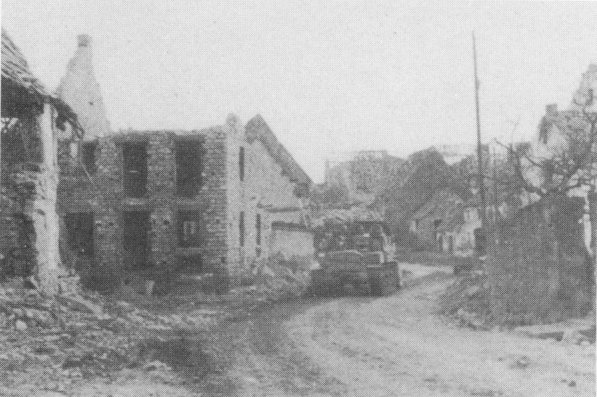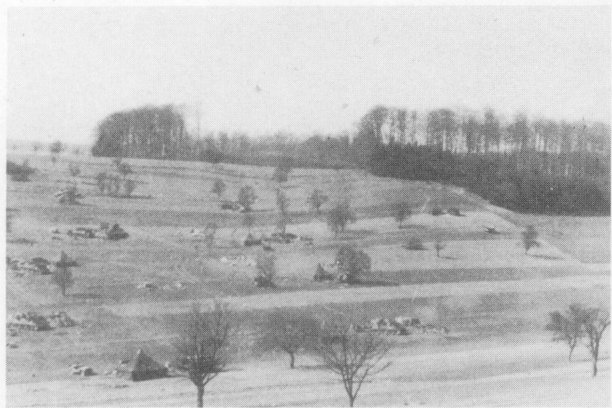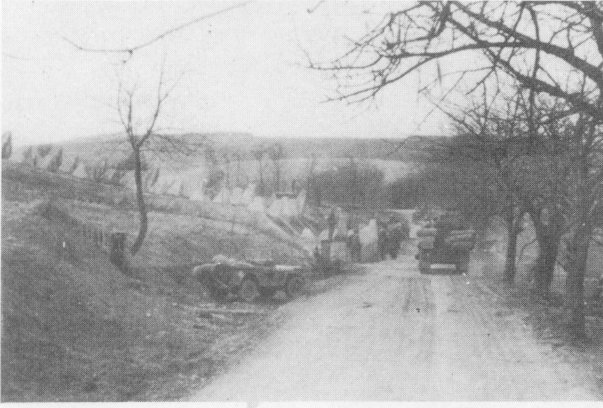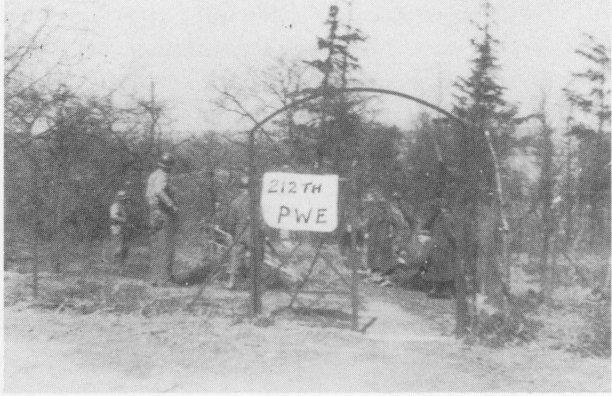 Luxembourg |
 Table of Contents |
 To the Russians |
 Luxembourg |
 Table of Contents |
 To the Russians |
Initially upon its return to France and assignment to the Seventh Army, the Sixth Armored Division was placed in XV Corps Reserve. The Siegfried Line was not yet pierced in the Seventh Army sector, and it was the mission of XV Corps to crack the line with infantry divisions before using armor in exploitation; the Sixth had a few more days of rest in store. But the artillery was detached from the division on March 13 and sent to support the initial corps attack east of Sarregnemines. Assigned to reinforce the 10th Field Artillery Battalion, Third Infantry Division, the 212th left its assembly area the morning of the 13th, and moved east through Dieuze and Sarre-Union to positions around Gros Rederching.

The battalion's first day at Gros Rederching was quiet, but once the corps attack started on March 15, firing became the heaviest of the entire war, despite the fact that the battalion's mission throughout was reinforcing. First came a prelude of some 1400 rounds on March 15th. A short pursuit was next as the Germans hurried behind their wall, and for the next two days displacements replaced firing; on March 16 the battalion moved to Bettviller first, then to Ormesviller, and the following day displaced across the German border to Altheim. There all the battalion's previous shooting records were eclipsed, as the battle got into the teeth of the Siegfried Line. 4,878 howitzer shells were fired on March 18; and on the 19th, before it was relieved of its mission at 1515, the battalion sent 3,830 rounds into the German defenses. The March 18 total established a record in the division unequaled by either of the other two battalions. During one 23-minute period that day -- 0512 to 0545 -- 1120 rounds were delivered by the battalion's 18 guns; tubes became too hot even to touch.
The firing was halted abruptly at 1515 the 19th, however, with word that the 63rd Infantry Division had achieved a breakthrough of the Siegfried north of Sarreguemines. The battalion was ordered south immediately with Combat Command A to assemble behind the 63rd in preparation for a dash through the hole. Ormesheim, a town ten miles north of Sarreguemines, became the 212th's position area, and the battalion remained there for the night. The reported breach of the line was not yet fully accomplished, but the job was expected to be complete by noon of the 2Oth, and ready for exploitation by Combat Command A.
It was ready. At 1200 March 20 Combat Command A moved north from its assembly area through Ormesheim and the Siegfried towns of Hassel and Kirkel -- and then out into the open where nothing but the darkness of the night stood between it and the Rhine. The command split into two columns at Limbach, just past Kirkel, and both forces reached the high ground short of the Rhine by morning without opposition. The south column held up at Biedesheim after 71 miles; the north task force stopped temporarily at Marienthal with 85 miles behind it, and then at noon moved right up to the Rhine at Rhine Durkeim, some 20 miles north of Worms. Both columns contacted Third Army elements advancing south from the Moselle River; the Saar pocket was closed. Net proceeds 80,000 German prisoners.
The cost to the 212th in casualties during the period was four. On March 14 at Gros Rederching Tec. 5 Dominic Papada of Service Battery was wounded by a sentry in the dark. The next day friendly ack-ack fire seriously wounded Tec. 4 Anthony J. DiAndrea, A Battery. During the night march, a C Battery half-track ran off the road in the poor visibility, overturned, and injured Cpl. Frank Todorsky. And John P. Garbowski of Headquarters Battery was wounded by a bomb fragment as jet- propelled German planes attacked the column in which he was riding on March 22.

For the first time during the war, the 212th operated during the drive to the Rhine as two separate units. When the combat command split into two task forces at Limbach, A and B Batteries took the left route in support of the Ninth Infantry Battalion, while C Battery with the assault gun battery of the 15th Tank Battalion attached moved in the right column to support Lagrew's tanks; Headquarters Battery was split and a half sent with each column. No support was needed in either column, however. The whole operation was little more than a night road march. It wasn't until the left column reached Rhine Durkeim, and A and B Batteries were in position behind Ostofen, that the first round was fired. The target was German anti-aircraft artillery on the east bank of the river. The troops manning the guns were completely surprised, seemingly oblivious that Americans were even near, and were quickly dispersed. No other forces of any type were visible across the Rhine, nor was there any apparent enemy activity except very scattered artillery fire which began to fall on Rhine Durkeim the next day. An almost unopposed Rhine crossing made elsewhere, and the Sixth had three more days of waiting.
The 212th spent its days changing positions. On March 22 the north half of the battalion joined the group at Biedesheim. The next day the entire battalion was ordered back to support the defensive position of the Ninth Infantry, and reoccupied the Ostofen positions in mid-afternoon. There on March 24 General Grow presented more awards to officers and men of the battalion. Lt. Lewis Blumberg was given the Silver Star Medal for the gallantry he displayed while flying his liaison plane over enemy lines near Sarreguemines during the November drive. Lt. Blumberg was also presented the Oak Leaf Cluster to the Air Medal for air observation sorties, as were Lts. Emil L. Barcklay, Frank W. Cleary, and Edward B. Ledford. Bronze Star Medals for heroic action in the Prum River crossing were awarded to Lt. Frederick C. Sorensen and Tec. 4 Anthony Quadagnito, both of C Battery; and to Sgt. Everett B. Mercer, Service Battery.

But the second Ostofen occupation was as short-lived as the first. The respite on the banks of the Rhine was about 'over. On March 24, word was received that the Sixth was again in General Patton's Third Army and would move through Third Army's Oppenheim bridgehead on the 25th. The division was about to finish the war as it had begun: in a Patton-maneuvered spearhead drive.

 Go to the 6th Armored Division Assoc. Home Page.
Go to the 6th Armored Division Assoc. Home Page.
 Information about the 212th FA and 6th Armored Division veterans' associations.
Information about the 212th FA and 6th Armored Division veterans' associations.
NOTE: Remove question mark from address below when sending email
This page is maintained by Bruce Frederick, EMAIL.
Last updated: August 9, 1997.